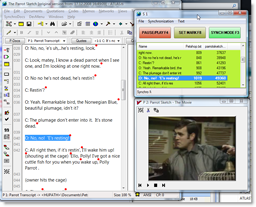

- Atlas.ti for mac transcription how to#
- Atlas.ti for mac transcription pdf#
- Atlas.ti for mac transcription software#
- Atlas.ti for mac transcription code#
Imported comments from Word will be coded with the code Imported comments.
Atlas.ti for mac transcription pdf#
If you added handwritten drawings or comments, those will be imported as image quotations (in ATLAS.ti Windows currently only supported for PDF documents). The text of the annotation will be added as a comment to the quotation. If you have made annotations in Word or PDF files, ATLAS.ti will turn the highlighted area into a quotation. PDF with annotations / Word files with comments It is a layout format and not meant for text processing. This is due to the nature of PDF as mentioned above. When you retrieve text from a coded PDF segment the output will be rich text. Another option is to apply character recognition in your PDF reader/writer software.
Atlas.ti for mac transcription software#
When scanning a text from paper, you need to use character recognition software (OCR, frequently provided with your scanner) in order to create a text PDF file. If you do the latter, then ATLAS.ti treats it as a graphic file, and you cannot search it or retrieve text. When preparing PDFs, you need to pay attention that you prepare a text PDF file and not a graphic PDF. If the PDF file has annotations, they are displayed in ATLAS.ti. When PDF was invented, its goal was to preserve the same layout for onscreen display and in print.

PDF files are perfect if you need the original layout.
Atlas.ti for mac transcription how to#
Examples of supported services are:įor further information on how to import transcripts from these services, see Importing Automated Transcripts in VTT and SRT format PDF files (Text and Graphic) Other sources are transcripts prepared automatically by services like Microsoft Teams, Zoom or YouTube in SRT or VTT format. This could mean - you or another person transcribing data for you - have used a specialized transcription software like: You can prepare your own transcripts in ATLAS.ti, or import transcripts that have been created elsewhere. You can add transcripts with timestamps and synchronize them with the original audio or video file. We however recommend using a dedicated transcription tool or use automated transcriptions. When adding an empty text document to an ATLAS.ti project, you can also transcribe your data in ATLAS.ti. This is useful to correct transcription errors, to change formatting, or to add missing information. Each person always works with her/his own copy of the data set within her/his own environment of ATLAS.ti.Text documents can be edited in ATLAS.ti. See Working with ATLAS.ti Libraries.ĭocument libraries CANNOT be shared. The location of where ATLAS.ti stores project related data can be determined by each user. If document editing is necessary, this needs to be done by the project administrator in the Master project! If they do, the edited documents cannot be merged, and you end up with duplicates. Otherwise, the documents are duplicated or multiplied during the process of merging. If all team members should work on the same documents, it is essential that only the project administrator is setting up the project adding all documents. A good time for doing this is after merging and before creating the new Master file. If new documents need to be added to the project, this needs to be done by the project administrator. Mary exports the new Master file and distributes it to all team members. The project administrator merges all sub projects and creates a new Master file. To combine the work of all team members, each team member creates a project bundle file and sends it to the project administrator. This means creating a project bundle file .Īll team members import the project bundle file and begin their work. The project administrator saves the project and exports it.

The project administrator adds documents to the project and possibly a list of codes. The project administrator sets up a Master project.


 0 kommentar(er)
0 kommentar(er)
